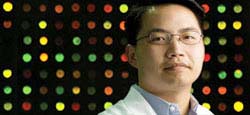Featured News
- – The New York Times
Why Do Women Have More Autoimmune Diseases? Study Points to X Chromosome
The molecules that silence a woman’s second X chromosome can confuse the immune system, a new study suggests.
- – The Guardian
‘Bond villain’ DNA could transform cancer treatment, scientists say
Discovery that extrachromosomal DNA act as cancer-causing genes seen as breakthrough that could lead to new therapies
- – Stanford Medicine
Scientists aim to disrupt DNA rings that block cancer treatments
The discovery that circles of free-floating DNA, or extrachromosomal DNA, help cancerous tumors evade treatment is driving a quest to disrupt them.
- – Stanford Medicine
Nine Stanford scientists receive cancer research funding totaling $13 million
The funding, from Cancer Grand Challenges, will help the researchers address difficult problems in cancer prevention, treatment-resistant cancers and therapies for pediatric solid tumors.
- – The New York Times
Scientists Are Just Beginning to Understand Mysterious DNA Circles Common in Cancer Cells
For years, researchers weren’t exactly sure what to make of these extra loops of genetic material . That’s quickly changing.
- – Stanford Medicine
Study identifies link between DNA-protein binding, cancer onset
Understanding when and where proteins bind to DNA may be the ticket to identifying cancer at the cellular level, according to researchers at Stanford.
- – Stanford Medicine
Online game challenges players to design on/off switch for CRISPR
Players will try to design a molecule that can turn CRISPR gene-editing on and off. Success could open the door to new research and therapies.
- – The New York Times
Telling Jewels From Junk in DNA
Some cellular DNA yields molecules that serve mysterious but important functions in the cell, new research suggests.
- – Stanford Medicine
Scientists unveil sex-linked control of genes
Many proteins interact with an RNA molecule called Xist to coat and silence one X chromosome in every female cell. Learning how genes are targeted and silenced may help researchers studying sex-specific diseases.
- – Stanford Medicine
‘Dead’ gene comes to life, puts chill on inflammation, researchers find
Learn how we are healing patients through science & compassion









